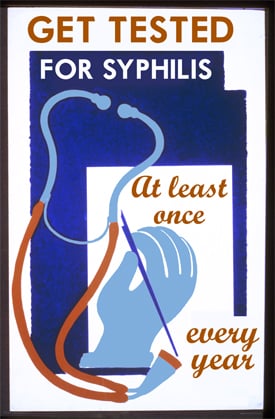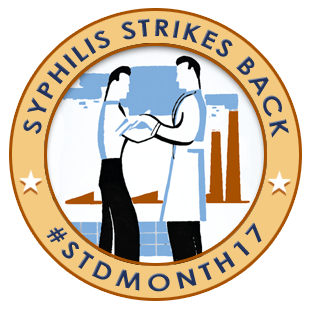
Gay & Bisexual Men Deserve The Best Health Possible

Syphilis may be making a comeback, but there are actions we can take and resources we can use to help reduce its impact. This page outlines specific prevention information for gay, bisexual, and other men who have sex with men (MSM) and healthcare providers, as well as information on how syphilis is affecting MSM.
MSM Remain Hardest-Hit By Syphilis
MSM are experiencing rates of syphilis not seen since before the HIV epidemic. In 2015, MSM made up the majority of primary and secondary (P&S) syphilis cases, and data suggest that an average of half of MSM who have syphilis are infected with HIV. Previous research also finds that MSM of color are particularly affected.
What Gay, Bisexual, and Other MSM Can Do to Prevent Syphilis
 Knowledge is key! Know what puts you at risk and how to avoid and/or lower those risks. The only way to avoid getting syphilis or other STDs is to not have anal, oral, or vaginal sex.
Knowledge is key! Know what puts you at risk and how to avoid and/or lower those risks. The only way to avoid getting syphilis or other STDs is to not have anal, oral, or vaginal sex.If you are sexually active, here are some ways to lower your chances of getting syphilis:
- Be in a long-term mutually monogamous relationship with a partner who has been tested and has negative STD test results.
- Reduce your number of sex partners; however, it’s still important that you and your partner get tested, and that you share your test results with one another.
- Use latex condoms the right way every time you have sex. Condoms prevent the spread of syphilis by preventing contact with a sore. Sometimes sores can occur in areas not covered by a condom, so you could still get syphilis from contact with these sores, even if you are wearing a condom.
- Get tested – it’s the only way to know if you have syphilis. CDC recommends all sexually active gay and bisexual men be tested for specific STDs, including syphilis, at least once a year and more frequently for those who have multiple or anonymous partners (i.e., at 3-to-6 month intervals). You should also familiarize yourself with all of CDC’s testing recommendations for MSM.
- Talk about it! Silence helps to fuel the spread of STDs.
- Have an honest and open talk with your healthcare provider about your sexual history and ask whether you should be tested for syphilis or other STDs. There are also resources available for finding an LGBT-friendly healthcare provider.
- Talk with your partner about sex and STDs BEFORE you have sex.
If you test positive, syphilis can be treated with the right medicine from your healthcare provider. It’s also important that your sex partner receives treatment. Even after you’ve been successfully treated, you can still get syphilis again. For this reason you must continue to take actions that will lower your risk of getting infected again.
What Healthcare Providers Can Do to Protect Their MSM Patients
Diagnosing and treating syphilis can be complicated. If you have questions, follow-up with your state or local health department or a local infectious disease doctor. We also have several other resources to help.
 YOU PLAY A PIVOTAL PART IN PREVENTING SYPHILIS – by keeping your patient safe and by stopping further transmission of syphilis within the community.
YOU PLAY A PIVOTAL PART IN PREVENTING SYPHILIS – by keeping your patient safe and by stopping further transmission of syphilis within the community.For sexually active patients:
- Take routine sexual histories, including routinely asking MSM about symptoms consistent with common STDs.
- Talk with them about prevention methods.
- Screen MSM patients at least once a year for syphilis and every 3-6 months for those at increased risk (i.e., history of syphilis infection, incarceration, drug use, or multiple/concurrent partners, and those who live in areas with high rates of syphilis).
If your patient is diagnosed with syphilis, take immediate action. Men diagnosed with syphilis should be treated with benzathine penicillin immediately. Also, all cases of syphilis should be reported to your state or local health department right away. CDC recommends reporting within 24 hours.
- Consider follow-up serologic testing for MSM due to data indicating they may be at risk for repeat infection.
- Advise your patient to tell their sex partner or partners about the infection and encourage them to get tested and treated to avoid reinfection.
Don’t forget these additional special considerations when serving your patients:
- Keep an eye out for ocular syphilis, especially among MSM patients and those living with HIV. These specific steps can help.
- Test patients diagnosed with P&S syphilis for HIV due to the increased likelihood of acquiring HIV if an individual has early syphilis. If you are serving patients in a geographic area where the HIV prevalence is high, retest for acute HIV in three months if the first test was negative.
Syphilis by the Numbers: MSM
Overall
- MSM account for 82% of male cases where the sex of the sex partner is known.
- The estimated P&S syphilis rate among MSM is 309 cases per 100,000 people. Rates varied by state from 73.1 cases per 100,000 people in Alaska to 748.3 cases per 100,000 people in North Carolina.
Testing Trends
A recent CDC analysis found a significant increase in syphilis screening in MSM (from 37% in 2008 to 49% in 2014), but testing rates were still low among those at high risk for the disease. Among those screened, the percentage who reported testing positive increased from 9% to 11%.
Screening was most common among MSM at highest risk, including those living with HIV (68%), and those with more than 10 sexual partners in the past 12 months (65%). Increases in diagnoses were greatest among MSM who were:
- black (9%-14%),
- living with HIV (15%-21%), and
- those with 10+ sexual partners (11%-17%).





















.jpg)












No hay comentarios:
Publicar un comentario